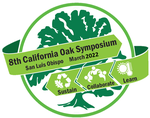#48

North Coast Oak Woodland Restoration: Assessment of Post-treatment Understory Conditions
Jeffery Stackhouse, University of California Cooperative Extension
Yana Valachovic, Lenya Quinn-Davidson, Brendan Twieg, University of California Cooperative Extension, and Chris Lee, CAL Fire
The loss of deciduous oak woodlands to native conifer encroachment is a major conservation concern in California, resulting in associated losses of wildlife habitat, traditional land uses, biodiversity, and other ecosystem services. These concerns have drawn increasing attention in the last decade, and oak woodland conservation and restoration efforts have gained momentum.
Throughout northwestern California, NRCS has played a critical role in initiating and funding oak woodland restoration. The agency has been on the cutting edge of the conifer encroachment issue, spurring great interest among private landowners and working to reduce negative trends for Quercus kelloggii and Q. garryana throughout the North Coast region. However, understanding of treatment effectiveness is largely anecdotal, and though the agency and its federal and private partners recognize the pressing need for oak woodland restoration, they lack data-driven guidance on treatment effectiveness and cost.
The purpose of the project was to assess effectiveness of conifer removal treatments and provide guidance to agencies and operators interested in doing this work. Among other aspects of woodland restoration, we analyzed lop and scatter, hand pile and burn, mechanical removal, and mastication treatment effects on tree regeneration, reestablishment of understory vegetation, and wildlife habitat conditions.
